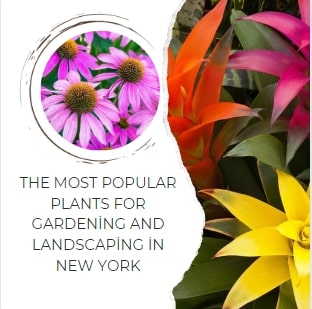The most popular plants for gardening and landscaping in New York
For those of you wondering what types of garden and landscape plants are best suited to New York’s climate, we have prepared information on some important plant varieties. Which plant and flower species are suitable for gardening and landscaping in the state. You can read the rest of our article to find out.
When selecting plants for your New York landscape, consider factors such as the specific hardiness zone of your area, the amount of sunlight your garden receives, and the soil conditions. It’s also a good idea to choose a mix of plants that offer variety in terms of height, color, texture, and bloom times to create an aesthetically pleasing and diverse landscape.
The best garden and landscape plants for New York
The most popular plants for gardening and landscaping in New York can vary based on personal preferences and regional factors. However, here are some plants that are commonly favored by gardeners and landscapers in New York:
- Knock Out Roses (Rosa ‘Knock Out’): These low-maintenance roses are known for their disease resistance and continuous blooming throughout the season, making them a popular choice for adding color to gardens.
- Hydrangeas (Hydrangea spp.): Hydrangeas are versatile shrubs known for their large, showy flower clusters. Varieties like the Bigleaf Hydrangea (Hydrangea macrophylla) and Panicle Hydrangea (Hydrangea paniculata) thrive in New York’s climate.
- Hostas (Hosta spp.): Hostas are shade-loving perennials that are valued for their attractive foliage. They come in a variety of colors, textures, and sizes, making them a popular choice for adding interest to shady areas.
- Daylilies (Hemerocallis spp.): Daylilies are hardy perennials that produce vibrant and long-lasting blooms. They are available in a wide range of colors and are well-suited for New York’s climate.
- Black-Eyed Susans (Rudbeckia hirta): These cheerful, yellow-gold flowers with dark centers are native to North America and thrive in New York gardens. They attract pollinators and add a pop of color to flower beds.
- Ornamental Grasses: Grasses like Feather Reed Grass (Calamagrostis x acutiflora), Switchgrass (Panicum virgatum), and Maiden Grass (Miscanthus sinensis) are popular for their graceful forms, texture, and ability to provide movement in the garden.
- Japanese Maples (Acer palmatum): Japanese Maples are small, ornamental trees that are highly valued for their stunning foliage colors and delicate structure. They can add an elegant touch to New York landscapes.
- Salvia (Salvia spp.): Salvia plants are loved for their vibrant flowers and ability to attract hummingbirds and butterflies. Varieties like Salvia nemorosa and Salvia officinalis are commonly grown in New York gardens.
- Coneflowers (Echinacea spp.): Coneflowers are native wildflowers that are drought-tolerant and attract pollinators. They come in various colors and are valued for their long-lasting blooms.
- Bee Balm (Monarda spp.): Bee Balm is a perennial herb that produces attractive flowers in shades of red, pink, and purple. It is prized for its fragrance and ability to attract pollinators.

These plants have gained popularity due to their adaptability to New York’s climate and their visual appeal. However, it’s important to consider factors such as sunlight, soil conditions, and personal preferences when selecting plants for your specific garden or landscape. Landscaping in New York >>
Suitable flowers and plants for the garden in New York
New York offers a wide range of plant options for landscaping, depending on factors such as climate, soil conditions, and personal preferences. Here are some plants that are generally suitable for landscaping in New York:
- Trees:
- Sugar Maple (Acer saccharum)
- Red Maple (Acer rubrum)
- Eastern Redbud (Cercis canadensis)
- American Sycamore (Platanus occidentalis)
- White Oak (Quercus alba)
- Red Oak (Quercus rubra)
- Eastern Hemlock (Tsuga canadensis)
- Shrubs and Bushes:
- Rhododendron (Rhododendron spp.)
- Azalea (Rhododendron spp.)
- Forsythia (Forsythia spp.)
- Spirea (Spiraea spp.)
- Winterberry (Ilex verticillata)
- Virginia Sweetspire (Itea virginica)
- Arrowwood Viburnum (Viburnum dentatum)
- Perennials and Flowers:
- Black-Eyed Susan (Rudbeckia hirta)
- Coneflower (Echinacea purpurea)
- Daylily (Hemerocallis spp.)
- Bee Balm (Monarda spp.)
- Astilbe (Astilbe spp.)
- Russian Sage (Perovskia atriplicifolia)
- Catmint (Nepeta spp.)
- Ornamental Grasses:
- Feather Reed Grass (Calamagrostis x acutiflora)
- Switchgrass (Panicum virgatum)
- Maiden Grass (Miscanthus sinensis)
- Little Bluestem (Schizachyrium scoparium)
- Fountain Grass (Pennisetum spp.)
- Groundcovers:
- Creeping Phlox (Phlox subulata)
- Sweet Woodruff (Galium odoratum)
- Bugleweed (Ajuga reptans)
- Lamium (Lamium spp.)
- Periwinkle (Vinca minor)
- Japanese Spurge (Pachysandra terminalis)
Suitable season for garden preparation in New York
The suitable season for garden preparation in New York typically depends on the specific tasks you need to undertake and the type of garden you are planning. However, a general guideline for garden preparation in New York can be as follows:
- Spring (March to May): Spring is a popular time for garden preparation in New York as the weather begins to warm up and frost risk decreases. Tasks you can focus on during this season include:
- Clearing out debris: Remove any winter debris, fallen leaves, and dead plant material from the previous year.
- Soil preparation: Prepare the soil by loosening it with a garden fork or tiller. Add organic matter, such as compost, to improve soil fertility and structure.
- Testing the soil: Take soil samples and get them tested to determine nutrient levels and pH. This information can guide you in choosing the right fertilizers and amendments.
- Planning and planting: Decide on the plants you want to grow and start sowing seeds indoors or directly in the garden, depending on the specific plant requirements and the last frost date for your area.
- Pruning: Prune shrubs and trees before they start actively growing. Remove dead or damaged branches and shape the plants as needed.
- Fall (September to November): Fall is another suitable season for garden preparation and maintenance in New York. The tasks you can focus on during this time include:
- Harvesting: Harvest crops and herbs that are ready for picking.
- Clearing out spent plants: Remove annuals and vegetables that have finished producing. Cut back perennial plants and clean up the garden beds.
- Soil amendment: Add compost or other organic matter to enrich the soil for the following season.
- Planting bulbs: Fall is the time to plant spring-blooming bulbs such as tulips, daffodils, and hyacinths.
- Mulching: Apply a layer of mulch around perennials and in garden beds to protect plants from winter cold and conserve moisture.

Preparing a garden and landscaping area in New York It’s important to note that these timeframes are general guidelines, and the specific timing for garden preparation can vary depending on factors such as your location within New York, weather conditions, and the specific plants you intend to grow. Always check the local weather forecast and consider the individual needs of your garden when planning your garden preparation activities.





